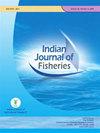Estimation of repeatability and phenotypic correlation of reproductive traits in zebrafish Danio rerio
IF 0.3
4区 农林科学
Q4 FISHERIES
引用次数: 0
Abstract
This study was conducted to estimate the repeatability and phenotypic correlation of reproductive traits of zebrafish Danio rerio, in captive condition. Breeding trials were conducted on 10 breeding pairs (2 male:1 female). The data on fecundity, fertility, hatchability and survival rate were recorded. The repeatability values were computed as a measure of consistency using the intra-class correlation coefficient. The repeatability estimates for fecundity, fertility, hatchability of total eggs, hatchability of fertilised eggs, survival rate of total eggs and survival rate of larvae were 0.701, 0.406, 0.336, 0.049, 0.295 and 0.314, respectively. Most of the reproductive traits analysed had moderate repeatability values barring the hatchability of fertilised eggs. The phenotypic correlation was calculated using the Pearson correlation method. The phenotypic correlations of fertility with hatchability of fertilised eggs; hatchability of total eggs; survival rate of total eggs and survival rate of larvae were highly significant (p≤0.01). This study provided valuable information on the consistency of reproductive parameters which would serve as model for conducting research in other fish species. Keywords: Genetic parameters, Phenotypic correlation, Repeatability, Reproductive traits, Zebrafish斑马鱼繁殖性状的重复性和表型相关性估计
本研究旨在评估斑马鱼在圈养条件下繁殖性状的可重复性和表型相关性。对10对育种对(2公1母)进行育种试验。记录了繁殖力、育性、孵化率、成活率等数据。使用类内相关系数计算重复性值作为一致性的度量。繁殖力、育性、总卵孵化率、受精卵孵化率、总卵存活率和幼虫存活率的重复性估计分别为0.701、0.406、0.336、0.049、0.295和0.314。除受精卵的可孵化性外,所分析的大多数生殖性状具有中等的可重复性值。表型相关采用Pearson相关法计算。育性与受精卵孵化率的表型相关性总卵的孵化率;总卵存活率和幼虫存活率极显著(p≤0.01)。这项研究提供了关于繁殖参数一致性的宝贵信息,可作为在其他鱼类中进行研究的模型。关键词:遗传参数,表型相关性,重复性,生殖性状,斑马鱼
本文章由计算机程序翻译,如有差异,请以英文原文为准。
求助全文
约1分钟内获得全文
求助全文
来源期刊

Indian Journal of Fisheries
FISHERIES-
CiteScore
0.90
自引率
20.00%
发文量
0
审稿时长
6-12 weeks
期刊介绍:
Indian Journal of Fisheries is published quarterly by the Indian Council of Agricultural Research (ICAR), New Delhi. Original contributions in the field of Fish and fisheries science are considered for publication in the Journal. The material submitted must be unpublished and not under consideration for publication elsewhere.
Papers based on research which kills or damages any species, regarded as thratened/ endangered by IUCN crieteria or is as such listed in the Red Data Book appropriate to the geographic area concerned, will not be accepted by the Journal, unless the work has clear conservation objectives.
 求助内容:
求助内容: 应助结果提醒方式:
应助结果提醒方式:


